 W
WAttacus atlas, the Atlas moth, is a large saturniid moth endemic to the forests of Asia. The species was first described by Carl Linnaeus in his 1758 10th edition of Systema Naturae.
 W
WCamellia reticulata is a species of flowering plant in the tea family Theaceae, native to southwestern China, in Yunnan Province. The wild populations are restricted to mixed mountain forest in western and central Yunnan.
 W
WCamellia yunnanensis is a 1.3–7 m tall shrub or small tree.
 W
WThe Chinese red-headed centipede, also known as the Chinese red head, is a centipede from East Asia and Australasia. It averages 20 cm (8 inches) in length and lives in damp environments.
 W
WThe Chuxiong fire-bellied newt is a species of salamander in the family Salamandridae that is endemic to China where it is only found in Guizhou and Yunnan. It also occurs in Kunming Lake.
 W
WThe large-spotted civet is a viverrid native to Southeast Asia that is listed as Endangered on the IUCN Red List.
 W
WCyprinus is the genus of typical carps in family Cyprinidae. Most species in the genus are of East Asia origin with only the common carp in Western Asia and Europe; this invasive species has also been introduced to many other regions around the world. Cyprinus are closely related to some more barb-like genera, such as Cyclocheilichthys and Barbonymus (tinfoils). The crucian carps (Carassius) of western Eurasia, which include the goldfish, are apparently not as closely related.
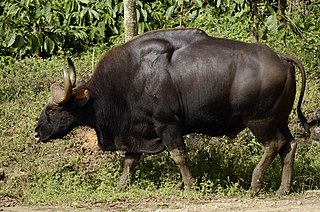 W
WThe gaur, also known as Indian bison, is native to South and Southeast Asia and has been listed as Vulnerable on the IUCN Red List since 1986. The global population has been estimated at maximum 21,000 mature individuals by 2016. It declined by more than 70% during the last three generations, and is extinct in Sri Lanka and probably also in Bangladesh. Populations in well-protected areas are stable and increasing.
 W
WThe eastern hoolock gibbon is a primate from the gibbon family, Hylobatidae. It is one of three species of hoolock gibbon. This species is found in extreme eastern corner of Assam and parts of Arunachal Pradesh, Myanmar east of the Chindwin River, such as the Mahamyaing Wildlife Sanctuary, and in south west Yunnan of China. The other hoolock gibbon, the western hoolock, occurs farther to the west. Indian records for the eastern species may actually represent the western hoolock.
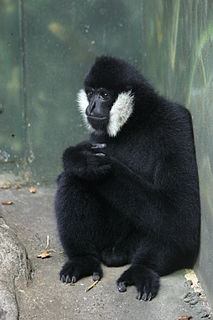 W
WThe northern white-cheeked gibbon is a species of gibbon native to South East Asia. It is closely related to the southern white-cheeked gibbon, with which it was previously considered conspecific. The females of the two species are virtually indistinguishable in appearance.
 W
WThe Gongshan muntjac is a species of muntjac living in the Gongshan mountains in northwestern Yunnan, southeast Tibet, Northeast India and northern Myanmar.
 W
WIchthyophis bannanicus, the Banna caecilian, is a species of amphibians in the family Ichthyophiidae found in southern China and northern Vietnam, presumably also in adjacent eastern Myanmar and northern Laos. Its natural habitats are subtropical or tropical moist lowland forests, rivers, intermittent rivers, plantations, rural gardens, heavily degraded former forest, irrigated land, and seasonally flooded agricultural land. It is threatened by habitat loss.
 W
WThe Indochinese leopard is a leopard subspecies native to mainland Southeast Asia and southern China. In Indochina, leopards are rare outside protected areas and threatened by habitat loss due to deforestation as well as poaching for the illegal wildlife trade. The population trend is suspected to be decreasing. As of 2016, the population is thought to comprise 973–2,503 mature individuals, with only 409–1,051 breeding adults. The historical range has decreased by more than 90%.
 W
WThe Shortridge's langur is a lutung native to Burma and China.
 W
WThe Bengal slow loris or northern slow loris is a strepsirrhine primate and a species of slow loris native to the Indian subcontinent and Indochina. Its geographic range is larger than that of any other slow loris species. Considered a subspecies of the Sunda slow loris (N. coucang) until 2001, phylogenetic analysis suggests that the Bengal slow loris is most closely related to the Sunda slow loris. However, some individuals in both species have mitochondrial DNA sequences that resemble those of the other species, due to introgressive hybridization. It is the largest species of slow loris, measuring 26 to 38 cm from head to tail and weighing between 1 and 2.1 kg. Like other slow lorises, it has a wet nose (rhinarium), a round head, flat face, large eyes, small ears, a vestigial tail, and dense, woolly fur. The toxin it secretes from its brachial gland differs chemically from that of other slow loris species and may be used to communicate information about sex, age, health, and social status.
 W
WThe pygmy slow loris is a species of slow loris found east of the Mekong River in Vietnam, Laos, eastern Cambodia, and China. It occurs in a variety of forest habitats, including tropical dry forests, semi-evergreen, and evergreen forests. The animal is nocturnal and arboreal, crawling along branches using slow movements in search of prey. Unlike other primates, it does not leap. It lives together in small groups usually with one or two offspring. An adult can grow to around 19 to 23 cm long and has a very short tail. It weighs about 450 g (1.0 lb). Its diet consists of fruits, insects, small fauna, tree sap, and floral nectar. The animal has a toxic bite, which it gets by licking a toxic secretion from glands on the inside of its elbows. The teeth in its lower jaw form a comb-like structure called a toothcomb that is used for scraping resin from tree bark.
 W
WThe Assam macaque or Assamese macaque is a macaque of the Old World monkey family native to South and Southeast Asia. Since 2008, the species has been listed as "near threatened" by the IUCN, as it is experiencing significant declines due to hunting, habitat degradation, and fragmentation.
 W
WThe northern pig-tailed macaque is a species of macaque in the family Cercopithecidae. It is found in Bangladesh, Cambodia, China, India, Laos, Myanmar, Thailand, and Vietnam. Traditionally, M. leonina was considered a subspecies of the southern pig-tailed macaque, but is now classified as individual species.
 W
WThe rhesus macaque is a species of Old World monkey. It is listed as least concern in the IUCN Red List of Threatened Species in view of its wide distribution, presumed large population, and its tolerance of a broad range of habitats. It is native to South, Central, and Southeast Asia and has the widest geographic range of all non-human primates, occupying a great diversity of altitudes and a great variety of habitats, from grasslands to arid and forested areas, but also close to human settlements.
 W
WThe stump-tailed macaque, also called the bear macaque, is a species of macaque found in South Asia. In India, it is found in south of the Brahmaputra River, in the northeastern part of the country. Its range in India extends from Assam and Meghalaya to eastern Arunachal Pradesh, Nagaland, Manipur, Mizoram and Tripura.
 W
WThe marbled cat is a small wild cat native from the eastern Himalayas to Southeast Asia, where it inhabits forests up to 2,500 m (8,200 ft) altitude. As it is present in a large range, it has been listed as Near Threatened on the IUCN Red List since 2015.
 W
WPhayre's leaf monkey, also known as Phayre's langur, is a species of lutung native to Southeast Asia, including India, Bangladesh, Myanmar, Thailand, Laos, Vietnam, and China. It is listed as Endangered on the IUCN Red List and is threatened by hunting and loss of habitat. The species epithet commemorates Arthur Purves Phayre.
 W
WThe black snub-nosed monkey, also known as the Yunnan snub-nosed monkey, is a large black and white primate that lives only in the southern Chinese province of Yunnan, where it is known to the locals as the Yunnan golden hair monkey (滇金丝猴) and the black-and-white snub-nosed monkey (黑白仰鼻猴). The common name, black snub-nosed monkey, is issued to Rhinopithecus strykeri, inhabiting in Northern Sino-Myanmar border. Coniferous and deciduous forests in the mountainous regions of Yunnan are the ideal terrain for these primates. It is threatened by habitat loss, and is considered an endangered species. With their unique adaptations to their environment, these monkeys thrive at extreme altitudes despite the below freezing temperatures and thin air. This primate's diet is mainly made up of the large amounts of lichens available in their region. Recent studies have provided more information on the black-and-white snub-nosed monkey, but there is still much to learn about them.
 W
WThe Myanmar snub-nosed monkey or black snub-nosed monkey is a critically threatened species of colobine monkey discovered in 2010 in northern Burma (Myanmar). It was formally described as a novel species of primate in 2011 based on its fur, beard and tail. Two groups of the species were discovered in China in 2011 and 2015, respectively.
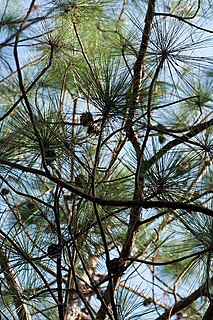 W
WPinus yunnanensis, the Yunnan pine, is a species of conifer in the family Pinaceae. It is found in the Chinese provinces of Yunnan, Sichuan, Guizhou, and Guangxi.
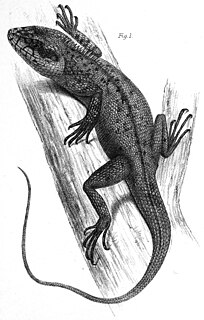 W
WPseudocalotes kakhienensis, the Kakhyen Hills spiny lizard, is a species of agamid lizard found in southern China, Myanmar, India, and northern Thailand. Type locality: Ponsee, Western Yunnan.
 W
WThe red panda is a mammal species native to the eastern Himalayas and southwestern China. It is listed as Endangered on the IUCN Red List because the wild population is estimated at fewer than 10,000 mature individuals and continues to decline due to habitat loss and fragmentation, poaching, and inbreeding depression. Despite its name, it is not closely related to the giant panda.
 W
WRhododendron spinuliferum is a species of Rhododendron native to Yunnan, southwestern Sichuan, and Guizhou China.
 W
WHodgson's brown-toothed shrew is a species of mammal in the family Soricidae. It is found in China, India, and Myanmar.
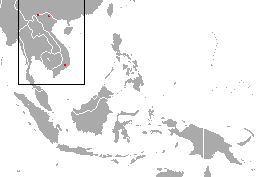 W
WThe small-toothed mole is a species of mammal in the family Talpidae. It is found in Di Linh, in southern Vietnam, and Rakho near the border of Vietnam and China, and in southern Yunnan, China, near the Vietnamese border. It is likely that it has a broader distribution, especially in places between the currently known locations.
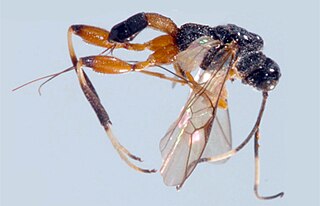 W
WSpasskia brevicarinata is a species of parasitoid wasp native to the Guizhou and Yunnan provinces of China. The female body is 8.2 millimeters long, with 7.3 millimeter forewings. The ovipositor, when fully extended, measures 5.5 millimeters long. General coloration is black, however, the first tergite is yellow. The fore and mid legs are also yellow, while the hind pair are reddish-brown and whitish-yellow. The antennae are dark brown, with a whitish-yellow stripe between the 11th and 15th flagellomeres No males of the species have been observed to date. The species name is derived from Latin brevi, meaning "short" and carinata, the word for "carina". This literally means that the species has a short dorsal carinae as part of the first tergite.
 W
WThe Mishmi takin is an endangered goat-antelope native to India, Myanmar and the People's Republic of China. It is a subspecies of takin.
 W
WThe back-striped weasel, also called the stripe-backed weasel, is a weasel widely distributed in Southeastern Asia. It is listed as Least Concern on the IUCN Red List in view of its presumed large population, occurrence in many protected areas, apparent tolerance to some degree of habitat modification and hunting pressure.
 W
WThe Yangtze giant softshell turtle, also known as the Red River giant softshell turtle, the Shanghai softshell turtle, the speckled softshell turtle, and Swinhoe's softshell turtle, is an extremely rare species of turtle in the family Trionychidae. The species is endemic to eastern and southern China and northern Vietnam. Only three living individuals are known, one in China (captive) and two in Vietnam (wild), following the deaths of a wild individual in Vietnam in January 2016 and a captive individual in China in 2019, and it is listed as critically endangered in the IUCN Red List. It may be the largest living freshwater turtle in the world. The female of the last breeding pair died at Suzhou Zoo in China in April 2019, making the species functionally extinct unless a wild female is found.
 W
WThe Yunnan hare is a medium-sized species of mammal in the family Leporidae. It has soft, flat, and long dorsal pelage which is grayish brown or dark gray in color, and whitish ventral pelage. It was considered endemic to China, but its presence was recorded in northern Myanmar in 2000. It is a herbivore, and forages on shrubs and forbs. It is rated as a species of least concern on the International Union for Conservation of Nature Red List of Endangered Species. The Red List of China's Vertebrates has listed the Yunnan hare as near threatened, almost meeting the criteria to be listed as vulnerable.